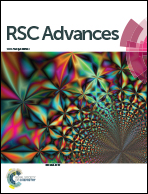Prenylated benzoylphloroglucinols and biphenyl derivatives from the leaves of Garcinia multiflora Champ†
Abstract
Garcimultiflorones H–J (1–3), three new polyprenylated benzoylphloroglucinols, multiflorabiphenyls B–D (4–6), three new biphenyl derivatives, and six known compounds, were isolated from an acetone extract of the leaves of Garcinia multiflora by bioassay-guided fractionation. The structures of the new compounds were elucidated by extensive 1D and 2D NMR spectroscopic analyses and mass spectrometry, and the absolute configurations of compounds 1–3 were determined by the comparison of experimental and calculated electronic circular dichroism (ECD) spectra. All of the isolates were evaluated for cytotoxic activities against several human cancer cell lines. Garcimultiflorone I (2) exhibited significant inhibitory activity against the SGC7901 and HCT116 cell lines, with IC50 values of 4.20 and 5.96 μM, respectively. A cell cycle analysis using flow cytometry showed that the compound arrests the cell cycle at the G1 phase and induces cell death. Moreover, Bcl-2, caspase-3, caspase-9, and PARP western blotting suggested that compound 2 can induce apoptosis. Taken together, these results suggest that compound 2 has anticancer activity that targets the cell cycle through apoptosis signalling pathways.


 Please wait while we load your content...
Please wait while we load your content...